Llandysilio, or Four Crosses, is a village in Montgomeryshire situated on the A483 main road to Welshpool, south of Oswestry, and just within the Welsh border with England. The men of the area who fell during the Great War are commemorated on a fine war memorial, in the form of a Celtic Cross, which is situated on the junction of the B4393 and A483. The memorial was unveiled in a ceremony attended by Major Wingfield in March 1921, and contains the names of eleven local men, one of whom gained the award of the Victoria Cross during the war.
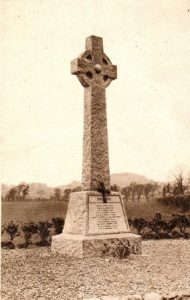
The Great War, 1914-1918
Edward Jones, Stoker 1st Class, K/20796, Royal Navy. Edward was born on 25 August 1894, the son of Thomas and Grace Jones, of 9, Canal Road, Four Crosses. He worked as a farm labourer prior to enlisting into the Royal Navy on 8 October 1913, and was posted to HMS Victory II for training as a Stoker. Over the coming years, Edward had several postings, interspersed with spells back at HMS Victory: HMS Attentive III; HMS Venerable; HMS Ganges; HMS Dolphin; HMS Titania; and HMS Crescent. His last posting was aboard the submarine HMS K17. She had been built by Vickers at Barrow-in-Furness, and launched on 10 April 1917. On 31 January 1918, K17 was taking part in fleet exercises, attached to the 13th Submarine Flotilla. K17 was leading the line of submarines, when she was hit by HMS Fearless, and sank in less than ten minutes, with all hands. Edward was 30-years-old when he was lost in the sinking. He has no known grave, and is commemorated on the Portsmouth Naval Memorial, Hampshire. His brother, William, was killed in France in 1917.
Thomas Pryce Jones, Private, 1186, Royal Welsh Fusiliers. Thomas was born at Horseshoe Cottage, Arddleen in 1895, the son of Thomas and Eliza Jones. His parents later resided at Dolfor Locks, while Thomas worked as a servant at Bellan Cottage, Mardu, Llandrinio prior to the war. He enlisted at Newtown into the 7th Battalion, Royal Welsh Fusiliers. The battalion was a Territorial unit, which mobilised for war at Newtown in August 1914, as part of North Wales Brigade, Welsh Division and moved to Conway until the end of the month, before moving to Northampton. Thomas died in Northampton on 12 November 1914. The remains of the 19-year-old were brought home for burial in St. Llwchaiarn’s Churchyard, Llanllwchaiarn.
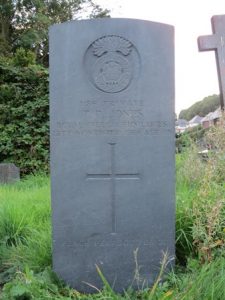
William Jones, Private, CH/1335(S), Royal Marine Light Infantry. William was born on 11 April 1896, the son of Thomas and Grace Jones, of 9, Canal Road, Four Crosses. He worked as a cowman at Street Farm, Guilsfield prior to the war. William enlisted into the Royal Marines at Birmingham on 17 December 1915, and was posted to the Recruit Depot at Deal for training. On 28 June 1916 he joined the Royal Marine Brigade, and on 25 September 1916 was posted to the 4th Entrenching Battalion, before being posted to the 1st Royal Marines Battalion, 63rd (Royal Naval) Division. He joined the Division on the Somme, in time to take part in its baptism of fire in France, during the Battle of the Ancre. William became ill during the winter, before re-joining the battalion at Arras the following spring. He was killed in action during the Battle of the Scarpe on 28 April 1917. The 21-year-old has no known grave and is commemorated on the Arras Memorial, France. His brother, Edward, was killed at sea the following year.
George Nelson Lloyd, Private, 30719, East Lancashire Regiment. George was the son of Richard and Jent Lloyd, of Court House Cottage, Llandysilio. He enlisted into the army at Wrexham, and after completing his training was posted to France, joining the 11th Battalion, East Lancashire Regiment, which was attached to 94 Brigade, 31st Division. He would have joined the battalion in the late summer of 1917, while it was in the Arras sector, near Ecurie. The Division was holding the Oppy Sector of the Arras front, and had a relatively peaceful time over the winter of 1917-18, suffering very few casualties. During February the 11th East Lancs transferred to 92 Brigade, in the same 31st Division, following the re-organisation of the British Army in France. Over the coming weeks the infantry battalions of the Division continued to carry out the usual routines of trench rotation, normally four days in the front line, four in support and four in reserve. The battalion was in reserve at Marquay when the Germans launched their Spring Offensive on 21 March 1918, along the section of front running from Croisilles to La Fère, and on the following day was ordered to move forward to Bailleulval, taking over a section of defensive line east of Boisleux St. Marc. On the following day the battalion took over a new defensive line in front of Ervillers, where it awaited the German onslaught. On 25 March information was received that the Germans had broken through at Gomiecourt, and the 11th East Lancs was ordered to withdraw. On 27 March the Germans hit the line held by the battalion, and fierce fighting ensued. George was killed in action near Adinfer Wood on the following day, 28 March 1918. The 19-year-old has no known grave and is commemorated on the Arras Memorial, France.
John Sidney Lloyd, Corporal, 337190, The King’s (Liverpool Regiment). John was the son of John Lloyd and Lucy Emma Lloyd, of School House, Llandysilio, Llanymynech. He worked as a schoolteacher in Liverpool prior to the war. John enlisted into the Royal Army Medical Corps at Liverpool on 31 August 1914, and was posted to the 1st West Lancs Field Ambulance, RAMC. John embarked for the Middle East on 3 April 1915, and served at Gallipoli following the landings later that month. By September his health had broken down, and John was invalided to Valetta Hospital, Malta, suffering from pyrexia and malaria. On 3 November 1915 he was invalided to England, and spent the next eight months recuperating. On 22 September 1916 John embarked for France at Southampton, and joined No 2 Territorial Base Depot at Rouen. He was then posted to the 2nd/1st West Lancs Field Ambulance, which was attached to the 57th (2nd West Lancashire) Division. On 20 September 1918 John was transferred to the 1/10th Battalion, The King’s (Liverpool Regiment), which was attached to 166 Brigade, 55th (West Lancs) Division. He was then appointed Corporal whilst undergoing a month’s training for a commission as an officer. John joined the battalion in reserve billets at Bethune and saw his first action as an infantryman five days later, when the battalion took part in an attack on the La Bassée Road. By now the Allies had launched a general offensive along the Western Front, and were driving towards the Hindenburg Line. On 3 October the 10th Liverpool’s advanced to a line running from La Bassée to Fromelles, and at dawn the following day, 4 October 1918, launched an assault against German positions facing the Division. John was unfortunately killed in action during heavy fighting that day. The 29-year-old is buried in Houchin British Cemetery, France.
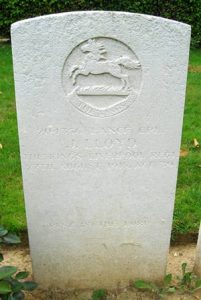
Thomas Tannatt Pryce, VC, MC and Bar, Captain, Grenadier Guards. Thomas was born at The Hague, Holland on 17 January 1886, the son of Thomas Pryce and Rosalia Susannah Pryce (nee Van Motman), of Pentreheylin Hall, Montgomeryshire. He was educated at Mill Mead School, Shrewsbury and at Shrewsbury School before becoming a member of the London Stock Exchange. Thomas married Margaret Sybil Fordham at Ashwell, Hertfordshire on 11 March 1908. Three weeks after the outbreak of war, Thomas joined the Honorable Artillery Company. He was commissioned into the 6th Gloucester’s on 11 October 1915, and the following month was awarded the Military Cross for his gallantry on 25-26 November 1915 at Gommecourt: ‘When in charge of an assaulting column he succeeded in entering the German Trenches unobserved, clearing and bombing large parties of the enemy who were crowded in deep dug outs. Although wounded, he extracted his men successfully in face of superior numbers.’ Thomas was invalided home, and returned to France in May 1916, gaining the award of a second Military Cross for his actions on the Somme: ‘He commanded the leading platoon in the assault with great dash and determination right up to the enemy’s trench, under heavy fire of all kinds. He set a fine example to his men.’ On 11 September 1916 he was transferred to the 4th Battalion, Grenadier Guards. His battalion had been in reserve at Bethencourt when the Germans had launched the Spring Offensive on 21 March 1918, but was soon rushed into action and saw heavy fighting as the Allied line withdrew west. By 2 April 1918, Thomas had been Mentioned in Despatches and promoted to Captain, officially taking over command of No. 2 Company, which he had in fact led since 25 March. The Guards Division then enjoyed several days rest, before moving north to the Merville area, and became caught up in the second phase of the German offensive, along the Lys, which was launched on 9 April. On 11-12 April 1918, Thomas led two platoons in a successful counter-attack at Vieux-Berquin. On the following morning, 13 April 1918, the Germans launched a series of attacks against his position, and Thomas was last seen leading a desperate bayonet charge, against overwhelming odds. For his actions, he was posthumously awarded the Victoria Cross. The citation for his award read:
‘For most conspicuous bravery, devotion to duty, and self-sacrifice when in command of a flank on the left of the Grenadier Guards. Having been ordered to attack a village he personally led forward two platoons, working from house to house, killing some thirty of the enemy, seven of whom he killed himself. The next day he was occupying a position with some thirty to forty men, the remainder of his company having become casualties. As early as 8.15 a.m., his left flank was surrounded and the enemy was enfilading him. He was attacked no less than four times during the day, and each time beat off the hostile attack, killing many of the enemy. Meanwhile the enemy brought three field guns to within 300 yards of his line, and were firing over open sights and knocking his trench in. At 6.15 p.m., the enemy had worked to within sixty yards of his trench. He then called on his men, telling them to cheer and charge the enemy and fight to the last. Led by Captain Pryce, they left their trench and drove back the enemy with the bayonet some 100 yards. Half an hour later the enemy had again approached in stronger force. By this time Captain Pryce had only 17 men left, and every round of his ammunition had been fired. Determined that there should be no surrender, he once again led his men forward in a bayonet charge, and was last seen engaged in a fierce hand-to-hand struggle with overwhelming numbers of the enemy. With some forty men he had held back at least one enemy battalion for over ten hours. His company undoubtedly stopped the advance through the British line, and thus had great influence on the battle.’ (London Gazette, 21 May 1918)
Thomas was also mentioned in despatches posthumously. The 32-year-old hero has no known grave and is commemorated on the Ploegsteert Memorial, Belgium. He is commemorated on war memorials at Shrewsbury School and on the Mill Mead School memorial, which is now located in St Giles’ Church, Shrewsbury. His medals are displayed in the Grenadier Guards RHQ, Wellington Barracks, London. His widow, Margaret, later remarried, and lost a son, George Desmond Waterall, aboard HM Submarine Triumph in 1942.

David Richards, Private, 51725, Cheshire Regiment. David was the son of David and Mary Richards, of Tybwc, Llanwyddelan. He had worked as a waggoner and had served with the Montgomeryshire Yeomanry prior to the war. David re-enlisted into the King’s Shropshire Light Infantry at Oswestry on 11 December 1915. He married Florence Selina Wilcox, of 13, Canal Road, Four Crosses, whilst home on leave on 3 January 1917. David embarked for France at Southampton on 19 October 1917, and joined the Infantry Base Depot at Rouen, initially destined for the 5th Battalion, King’s Shropshire Light Infantry, but was instead transferred to the 15th Battalion, Cheshire Regiment, which was attached to 105 Brigade, 35th Division. He joined the battalion at Ypres on 25 October, where it had suffered heavy casualties whilst in the line near the Houthulst Forest. On 1 November the battalion was relieved from the line and moved back to a rest camp at Proven, enjoying almost three weeks in reserve before moving back into the line near Poelcapelle towards the end of November for a short spell holding the new front line. The battalion moved back into reserve throughout December, and only had a couple of short spells back in the line in January and February 1918 before entraining for the Somme on 23 March, where the Division had been sent to bolster the beleaguered Allied lines, following the launching of the German Spring offensive of 21 March. By 24 March the 35th Division had reached Maricourt, taking over the support lines, but almost immediately became caught up in heavy fighting which raged for days. David was posted as missing, believed killed in action near Buire-sur-Ancre on 28 March 1918. No trace of the 34-year-old was ever found, and he is commemorated on the Pozieres Memorial, France.
Charles Roberts, Corporal, 16182, King’s Shropshire Light Infantry. Charles was the son of Robert and Mary Ann Roberts, of The Smithy, Four Crosses. He worked as a tailor, and married Amy Elizabeth Brown on 1 July 1910, before the couple set up home at 2, Domgay Road, Four Crosses. Charles enlisted into the King’s Shropshire Light Infantry at Oswestry soon after the outbreak of war, and embarked for France on 4 May 1915, joining the 1st Battalion, KSLI, which was attached to 16 Brigade, 6th Division. Charles probably saw his first action with the battalion during the Action at Hooge during June 1915, but was possibly wounded, as he was then transferred to the 7th Battalion, KSLI. The battalion was attached to 76 Brigade, 25th Division, and had landed at Boulogne on 15 October 1915, before moving to positions in the Ypres Salient and took over positions around St. Eloi. Towards the end of June 1916, the Division was relieved, and began to move south, to the Somme sector, reaching Corbie, in the Somme Valley, by 6 July. The 7th KSLI then moved to Carnoy, and on the night of 13-14 July moved into the front line, under cover of darkness. At 03.30 on 14 July 1916 the 7th KSLI launched a frontal attack against the German line defending High Wood. Over 400 casualties were suffered during the terrible fighting which raged throughout the day. Charles was among over 150 men killed in action during the attack that morning, the remainder of the casualties had been badly wounded. The 27-year-old has no known grave and is commemorated on the Thiepval Memorial, France.
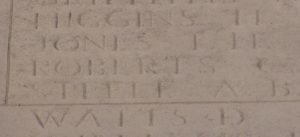
Alfred Pryce Thomas, Private, RX4/234838, Royal Army Service Corps. Albert was the son of Pryce Thomas and Sarah Thomas (nee Evans), of Fir Tree Farm, Bryn-Mawr, Llanymynech. He enlisted at Welshpool into the army and was posted to the Anti-Aircraft Company, Army Service Corps. Alfred had served overseas at some time during the war, but must have taken ill and been invalided home. He died of disease at Exeter on 30 September 1917, aged 22. Alfred’s remains were brought home for burial in St. Tysilio’s Churchyard, Llandysilio on 4 October.
Noel Price James Turner, Lieutenant, Welsh Regiment. Noel was born on 7 December 1878, the son of the Reverend John James Turner and Harriette Augusta Turner (nee Harrison), of Pentreheylin, Llanymynech. He was educated at Charterhouse and at Keble College, Oxford and had served during the Boer War with the Montgomeryshire Yeomanry. Noel married Minnie Beck, an Australian, at Guilsfield, near Welshpool on 25 September 1902 and the couple lived at Sylfaen Hall, Welshpool. Noel was commissioned into the South Wales Borderers on 4 September 1914 and was attached to the 2nd Welsh until joining the 1st Battalion, South Wales Borderers in March 1915. Both the 2nd Welsh and the 1st SWB were attached to 3 Brigade, 1st Division, and had taken part in every major action of the war thus far. By May 1915 the Allies had decided to launch a combined British and French offensive, and the British were tasked with an assault against the Aubers Ridge, the same sector as the unsuccessful Battle of Neuve Chapelle the previous month. The Germans had by now strengthened their defences, and when the battle was launched on 9 May 1915, the 1st Division and the Indian Meerut Division launched their assault on a 2,000-metre frontage from Chocolat Menier Corner, north-east of Festubert, to the Port Arthur cross-roads, south of Neuve Chapelle. Artillery support was inadequate, and the wire had not been cut by the time the troops advanced, and heavy losses were suffered. Noel was badly wounded during the initial charge and was evacuated to hospital in Bethune, where he died later that day, 9 May 1915, aged 36. He is buried in Bethune Town Cemetery, France. Both his sons served as officers with the 7th Battalion, Royal Welch Fusiliers during World War Two.
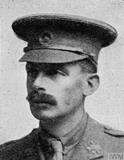

Richard Edward Windsor, Private, 69218, Royal Welsh Fusiliers. Richard was the son of William and Emma Windsor, of Bryn Mawr, Llanymynech. He enlisted into the Royal Welsh Fusiliers, and was drafted to France during the winter of 1917-18, to join the 17th Battalion, Royal Welsh Fusiliers, which was attached to 115 Brigade, 38th (Welsh) Division. The Division was by then in the Armentieres sector, where it had been moved following heavy losses during the Battle of Pilckem Ridge. The Division remained in the area over the winter before being moved to positions north of Albert, at Bouzincourt Ridge, at the end of March 1918, relieving the battered 2nd and 47th Divisions. It held this sector, again carrying out minor operations and trench raids, over the coming months, before taking part in the great offensive of 21 August 1918, and began its advance towards the Hindenburg Line. Over the coming weeks the Division drove across the old Somme battlefields of 1916, towards the Canal du Nord, and once the Hindenburg Line had been broken, drove over the Selle and Sambre Rivers, capturing the Forest of Mormal by the time of the Armistice. Richard survived the war and returned home, but died on 7 September 1919, aged 24. He was buried in St. Tysilio’s Churchyard, Llandysilio, on 10 September.
World War Two, 1939-45
Gwilym Clwyd Jones, Driver, T/150231, Royal Army Service Corps. Gwilym was born at Ruthin on 10 February 1912, the son of Elias Jones and Elizabeth Jones (nee Hughes). He worked as a motor driver prior to the war, and in 1941 married Nesta Evans, of Four Crosses. Gwilym enlisted into the Royal Army Service Corps, and became a driver with 179 Field Ambulance, RAMC. The unit landed in Normandy with the 11th Armoured Division, following the D-Day landings, and saw heavy action over the coming weeks during Operation Epsom, the crossing of the River Odon. Gwilym was killed in Normandy on 3 August 1944, aged 32. He is buried in Bayeux War Cemetery, France. There are no WW2 names on the Four Crosses war memorial.